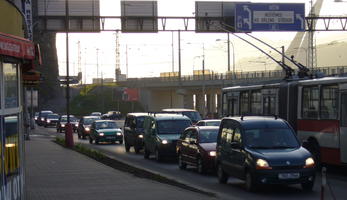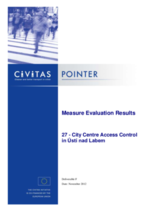City Centre Access Control
Summary
A study was elaborated in order to propose possible options for regulating traffic in the centre of Ústí nad Labem, with the emphasis on describing expected positive impacts, considering the risks and negative consequences of individual actions and inter-comparison of these results with appropriate conclusions.
Implementing sustainable mobility
Ústí nad Labem is becoming gradually more and more congested with vehicles as the demand for travel grows. The city centre is overloaded by individual transport and the con-coordination and non-regulated supplying of business activities creates problems. The city has a target to improve the urban environment and ensure a better life for its inhabitants.
The city centre covers a rather small area. Its function is various, from providing residents with housing, offering cultural realisation, business opportunities, shops, services, offices, medical facilities, etc. Therefore, accessibility of the centre has to be on a high level.
A feasibility study was developed to determine feasibility of implementing a city centre access control and develop a plan of measures that could be implemented as part of the Sustainable Urban Transport Plan in Ústí nad Labem with the aim to reduce the volume of traffic in the centre and to improve the environment in the city.
The study was aimed at following issues:
- how to reduce the proportion of transit traffic
- how to reduce the number of vehicles entering the city centre
- how to improve conditions for safe walking and cycling
- how to reduce traffic congestion
- how to improve traffic safety and traffic flow
- how to improve conditions for public transport services in the area
- how to solve the parking problem in the city centre
Progress
The study analysed reasons for traffic problems in the city. Transport links and development of motorisation in the city were described. Current transport policy of the city was presented and suitable tools of demand management, traffic organisation and traffic management were identified. Specifications of the city centre were examined. Traffic intensity of individual roads wad surveyed.
Traffic regulations currently applied in the city were described and presented in a map. Parking conditions were taken into consideration. Condition for public transportation and cycle transport were analysed.
Based on the analyses, suitable regulatory measures for Ústí nad Labem were designed.
The main task was to eliminate the transit traffic (which brings no benefit to the area) from the city centre and to transfer it on suitable routes outside the central part. The restrictions were proposed to have impact on the whole road network in the city and to improve traffic flow and traffic safety in the city. Alternative routes for transit traffic were proposed on the current road network and marked on the map.
Specific proposed scenarios involved following restrictions:
- Access to the city centre allowed for transport services only
- Access for freight vehicles and vehicles over 3.5 tonnes prohibited
- System of roads with regulated traffic (one-way roads and impassable roads in the city centre)
- Traffic signal lights discouraging drivers
- Paid entrance (toll) for accessing the city centre
- Traffic calmed zones (pedestrian zones, residential zones, speed 30 zones)
- Paid parking zones and the system Park&Ride or Park&Go
- Supporting measures (improvements of PT services, improvements for cyclists and pedestrians, parking solutions outside the city centre and promotion)
Outcomes
Based on the analyses, the major traffic problems were identified as:
- High intensity of vehicles
- Unnecessary transiting traffic
- Significant deficit of parking places
Advantages and disadvantages of individual regulatory measures were compared and the optimal solution consisting of combination of restrictions was presented. The suitable solution consists of complex, expensive, and unpopular long-term processes, which bring the greatest positive effect to the city. It satisfies the following conditions:
- Reduced number of vehicles in the centre – provide residents and visitors with suitable equivalent, motivate towards desired habit change
- Reduced traffic performance in the area – necessary traffic operates on the shortest routes
- Safer traffic – reduction of accidents, injuries and deaths, lower financial losses
- Better conditions for PT, cycling and walking – motivation for users, increase of use, improve present state of facilities and services
- Lower negative impact on the environment – limiting motorised transport and its effects
- Preserved urban functions – satisfy needs of inhabitants
It was recommended that the city centre should be marked as a zone regulated in following ways:
- Access allowed only for transport services (including residents and PT)
- Access allowed only for vehicles meeting low emission standards (not applied on transport services)
- Maximum speed 30 km/hour
- Park & Go system implemented
- Implementation of a specific residential zone
- Establishing a system of roads with regulated traffic
The resulting changes in traffic load were presented.
Regulations proposed for the city centre are aimed at calming the area, improving conditions for its users. It is supposed to be a quiet zone for residents and visitors, prioritising non-motorised modes of transport – walking and cycling.
In the study of city centre access control, all the regulatory tools applicable on the city centre were listed and analysed, compared and considered for application. As a result, some measures were recommended as suitable for limiting the entrance to the centre of Ústí nad Labem. It was revealed, that the proper solution is a combination of tools forming a comprehensive system of traffic regulations. The solution is not eliminating traffic completely.
It rather encourages car users to change their habits and use other means of transport. Due to traffic restrictions, the centre can become a calm zone more attractive for both residents and visitors.








